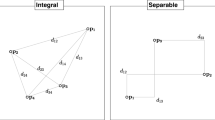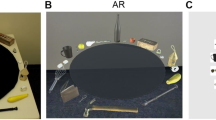Abstract
INDSCAL (INdividual Differences SCALing) is a useful technique for investigating both common and unique aspects of K similarity data matrices. The model postulates a common stimulus configuration in a low-dimensional Euclidean space, while representing differences among the K data matrices by differential weighting of dimensions by different data sources. Since Carroll and Chang proposed their algorithm for INDSCAL, several issues have been raised: non-symmetric solutions, negative saliency weights, and the degeneracy problem. Orthogonal INDSCAL (O-INDSCAL) which imposes orthogonality constraints on the matrix of stimulus configuration has been proposed to overcome some of these difficulties. Two algorithms have been proposed for O-INDSCAL, one by Ten Berge, Knol, and Kiers, and the other by Trendafilov. In this paper, an acceleration technique called minimal polynomial extrapolation is incorporated in Ten Berge et al.’s algorithm. Simulation studies are conducted to compare the performance of the three algorithms (Ten Berge et al.’s original algorithm, the accelerated algorithm, and Trendafilov’s). Possible extensions of the accelerated algorithm to similar situations are also suggested.
Similar content being viewed by others
References
Arabie P, Carroll JD, DeSarbo WS (1987) Three way scaling and clustering. Sage Publications, Newbury Park
Bennani Dosse M, Ten Berge JMF (2008) The assumption of proportional components when Candecomp is applied to symmetric matrices in the context of Indscal. Psychometrika 73: 303–307
Carroll JD, Chang JJ (1970) Individual differences and multidimensional scaling via an N-way generalization of Eckart-Young decomposition. Psychometrika 35: 282–319
Carroll JD, Chang JJ (1972) IDIOSCAL (Individual Differences In Orientation SCALing): a generalization of INDSCAL allowing IDIOsyncratic reference systems as well as an analytic approximation to INDSCAL. Paper presented at the Psychometric Society, Princeton
Carroll JD, De Soete G, Pruzansky S (1989) An evaluation of five algorithms for generating an initial configuration for SINDSCAL. J Classif 6: 105–119
Clarkson DB (1988) A least squares version of algorithm AS 211: the F-G diagonalization algorithm. Appl Stat-J Roy St C 37: 317–321
De Leeuw J, Pruzansky S. (1978) A new computational method to fit the weighted euclidean distance model. Psychometrika 43: 479–490
Fletcher R (1981) Practical methods of optimization, constrained optimization, vol. 2. Wiley, Chichester
Flury B (1988) Common principal components and related multivariate models. Wiley, New York
Flury B, Gautschi W (1986) An algorithm for simultaneous orthogonal transformation of several positive definite symmetric matrices to nearly diagonal form. SIAM J Sci Stat Comp 7: 169–184
Golub G, van Loan C (1996) Matrix computations, 3rd edn. The Johns Hopkins University Press, London
Harshman RA (1978) Models for analysis of asymmetrical relationships among N objects or stimuli. Paper presented at the first joint meeting of the psychometric society and the society of mathematical psychology, Hamilton, ON
Helm CE (1964) Multidimensional ratio scaling analysis of perceived color relations. J Opt Soc Am 54: 256–262
Jacobowitz D (1975) The acquisition of semantic structures. Unpublished doctoral dissertation, University of North Carolina.
Jennrich RI (2001) A simple general procedure for orthogonal rotation. Psychometrika 66: 289–306
Kaiser HF (1958) The varimax criterion for analytic rotation in factor analysis. Psychometrika 23: 187–200
Kiers HAL (1989a) A computational short-cut for INDSCAL with orthonormality constraints on positive semi-definite matrices of low rank. Comput Stat Quart 2: 119–135
Kiers HAL (1989b) An alternating least squares algorithm for fitting the two- and three-way DEDICOM model and the IDIOSCAL model. Psychometrika 54: 515–521
Kiers HAL (1991) Hierarchical relations among three-way methods. Psychometrika 56: 449–470
Kiers HAL, Takane Y (1994) A generalization of GIPSCAL for the analysis of nonsymmetric data. J Classif 11: 79–99
Krijnen WP, Dijkstra TK, Stegeman A (2008) On the non-existence of optimal solutions and the occurrence of “degeneracy” in the Candecomp/Parafac model. Psychometrika 73: 431–439
Kroonenberg PM (1983) Three-mode principal component analysis. DSWO Press, Leiden
Lingoes JC, Roskam EE (1973) A mathematical and empirical analysis of two multidimensional scaling algorithms. Psychometrika Monograph Supplement 19
Loisel S, Takane M (2009) Fast indirect robust generalized method of moments. Comput Stat and Data An 53: 3571–3579
Nguyen TK, Oshima-Takane Y (2008) Do 2- to 3-year-old children use functional or shape cues to name objects? Poster presented at the International Society on Infant Studies, Vancouver, BC.
Rosenberg S, Kim MP (1975) The method of sorting as a data-gathering procedure in multivariate research. Multivar Behav Res 10: 489–502
Schiffman SS, Reynolds ML, Young FW (1981) Introduction to Multidimensional Scaling. Academic Press, New York
Smith DA, Ford WF, Sidi A (1987) Extrapolation methods for vector sequences. SIAM Review 29: 199–233
Stegeman A (2007) Degeneracy in Candecomp/Parafac explained for p × p × 2 arrays of rank p + 1 or higher. Psychometrika 71: 483–501
Takane Y (2007) Applications of multidimensional scaling in psychometrics. In: Rao CR, Sinharay S (eds) Handbook of statistics: Pyschometrics, vol 26. Elsevier BV, Amsterdam, pp 359–400
Takane Y, Zhang Z Algorithms for DEDICOM: acceleration, deceleration, or neither? J Chemometr (in press)
Ten Berge JMF (1984) A joint treatment of varimax and the problem of diagonalizing symmetric matrices simultaneously in the least squares sense. Psychometrika 49: 347–358
Ten Berge JMF, Kiers HAL (1991) Some clarifiation of the CANDECOMP algorithm applied to INDSCAL. Psychometrika 56: 317–326
Ten Berge JMF, Kiers HAL, De Leeuw J (1988a) Explicit candecomp/parafac solutions for a contrived 2 × 2 × 2 array of rank three. Psychometrika 53: 579–584
Ten Berge JMF, Knol DL, Kiers HAL (1988b) A treatment of the orthomax rotation family in terms of diagonalization, and a re-examination of a singular value approach to varimax rotation. Comput Stat Quart 3: 207–217
Ten Berge JMF, Kiers HAL, Krijnen WP (1993) Computational solutions for the problem of negative saliences and nonsymmetry in INDSCAL. J Classif 10: 115–124
Trendafilov N (2002) GIPSCAL revisited: a projected gradient approach. Stat Comput 12: 135–145
Trendafilov N (2004) Orthonormality-constrained INDSCAL with nonnegative salience. In: Legan A et al (eds) Computational science and its applications Lecture Notes in Computer Science 3044 Part II. Springer, Berlin, pp 952–960
Zhang Z, Takane Y Statistics: multidimensional scaling. In: Baker E, McGaw B, Peterson PP (eds) International encyclopedia of education, 3rd edn. Elsevier, Oxford (in press)
Author information
Authors and Affiliations
Corresponding author
Additional information
The work reported in this paper has been supported by SSHRC Research Grant 36952 to the first author, and by NSERC Discovery Grant 290439 to the third author.
Rights and permissions
About this article
Cite this article
Takane, Y., Jung, K. & Hwang, H. An acceleration method for Ten Berge et al.’s algorithm for orthogonal INDSCAL. Comput Stat 25, 409–428 (2010). https://doi.org/10.1007/s00180-010-0184-6
Received:
Accepted:
Published:
Issue Date:
DOI: https://doi.org/10.1007/s00180-010-0184-6
Keywords
- Multi-way data analysis
- Minimal polynomial extrapolation (MPE)
- Singular value decomposition (SVD) algorithm
- Dynamical system algorithm




